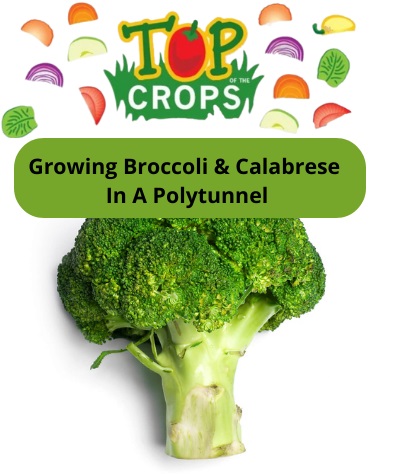Welcome to Top of the Crops! Today, you will learn how to grow broccoli and calabrese in a polytunnel. Produce bountiful broccoli crops in your polytunnel in the UK all year round with this insightful guide. For further gardening tips, be sure to check out our blog Polytunnel Gardening.
Broccoli is a member of the cabbage family all polytunnel gardeners in the UK should grow. By choosing the right types of broccoli to grow, you can potentially harvest and eat broccoli from your polytunnel garden practically all year round.
| Jan | Feb | Mar | Apr | May | Jun | Jul | Aug | Sep | Oct | Nov | Dec | |
| Sow |  |
 |
 |
 |
 |
|||||||
| Plant |  |
 |
 |
 |
||||||||
| Harvest |  |
 |
 |
 |
 |
 |
 |
 |
 |
 |
 |
 |
There are several different types of broccoli, all of which are in the Italica cultivar group of the species Brassica oleracea.
There are Calabrese broccoli varieties, which form larger heads, and which are harvested in the summer after the spring when they are planted.
Then there are traditional sprouting broccoli types, which produces smaller sprouts or flower bud florets over a longer period of time. Sprouting broccoli is usually considered a crop for the late winter or spring, but varieties are available these days that are ready for harvest much sooner, from summer onwards.
There are also a few interesting perennial relatives, and hybrids with other close relations such as broccolini or 'tender stem broccoli' as it is sometimes called.
Broccoli is usually grown for its stems and closed flower buds, but the leaves, like those on other brassicas, are also edible and should be considered an additional yield from the plants. Larger leaves can be cooked like cabbage or kale, while smaller ones can even work in salads.
Whichever type of broccoli you choose to grow, it is important to remember that broccoli of any of these types requires:
Full sun, or very light shade.
A sheltered location.
Temperatures between around 4 and 24ºC.
A moist yet moderately free draining, fertile soil with a pH that is ideally between 6 and 7.
To grow broccoli in your garden you will need:
Broccoli seeds.
Seed trays/ pots/ soil blocks etc... and potting mix - for seed starting.
A suitable garden bed, container, or other growing location.
Facility to water your crop.
Organic material for mulch/ feeding.
Broccoli is not a particularly challenging crop to grow as long as you bear its basic needs in mind and plant it in the right spot. Timing the sowing and planting correctly is important if you want to eat your own home-grown broccoli over as much of the year as possible.
It is important to make sure that the soil is healthy and rich in organic matter in your intended planting area. Remember, broccoli needs a spot with enough sun, where it is sheltered.
Avoid placing broccoli in soil that may become waterlogged – especially when growing a type of broccoli that will remain in place over the winter months. Make sure the pH is not too low as this can increase the chance of club root disease. Lime where necessary.
You might grow broccoli outside for much of the year, and in a polytunnel broccoli could be growing practically all year round. Consider when deciding where to plant it when you will harvest, and how this crop will fit into your overall garden plans.
Broccoli can be sown indoors or outside, directly where it is to grow. You can generally sow indoors from around March and outside from April, after the last frost date in your area. You can continue to sow small batches of broccoli up until the middle of summer.
Broccoli is best started indoors when it is sown early in the spring but it can also be beneficial to sow indoors throughout the sowing period if you encounter problems with rodents or birds eating seeds in your garden before or soon after they sprout.
Use soil blocks or biodegradable pots filled with a suitable seed starting potting mix to sow broccoli seeds as these can just be transferred straight to their final growing positions later without risking any root disturbance.
Seeds should be sown around 2cm deep, two to each block or pot. once these emerge, which should be within a couple of weeks at the longest, thin out the weaker of the two to leave just one seedling in each.
One other option is to grow broccoli for micro-greens. In this case, simply broadcast seeds over a seed tray or other shallow container and add them to salads or use the seedlings as a garnish while they are still very small. The micro-greens broccoli will be ready to harvest in just a few short weeks.
If you prefer to direct sow broccoli seeds, you can do so from April onwards, depending on where you live and the last frost date in your area. You can either sow seeds into a temporary seed bed for later transplantation, or you can sow them into their final growing positions if the space is available.
Sow the seeds into drills around 2cm deep and aim for a spacing of around 7.5cm initially. Thin to leave an eventual spacing of around 60-80cm between plants, depending on which variety you have chosen to grow.
If you are direct sowing, remember that seeds and young seedlings will usually need some protection. So cover your crop with row covers or cloches to prevent potential problems.
If you sowed seeds indoors, or into seed beds, these should be transplanted to their final growing positions as soon as they reach around 10-15cm in height. Make sure you disturb the roots as little as possible, and harden off seedlings sown indoors before you place them into their final positions.
Aim to place the broccoli plants around 60-80cm apart, depending on variety, with a similar dimension between rows if you are planting more than one. You may sometimes be able to plant more closely, but often too close a spacing will reduce yields.
Water your new plants into place, firming the soil well around their roots. And add an organic mulch around them.
Protect the broccoli plants right away with a mini polytunnel or row cover over them to protect them from pests.
If you sow broccoli regularly, you can enjoy harvests from mid summer right through until the following spring. Plants take between 4-10 months to start cropping depending on the variety and when they were sown.
Calabrese broccoli will produce one large head and when this is harvested, several more much smaller ones. Sprouting broccoli will form smaller heads, and continue to produce these over a much longer period. The more shoots you harvest the more the plant will produce.
Both types of broccoli are ready when the heads are well formed but the flower buds are still tightly closed.
Of course, broccoli can then be used in a wide range of recipes. There are, of course, plenty of healthy and delicious ways to cook and eat this green vegetable.
It is best if possible to eat broccoli as soon as possible after harvesting. But it will keep in the fridge for a few days, and can also be blanched and frozen for later use. If you are wondering how to store broccoli, you might also explore other methods, but freezing is usually best.
Caring for broccoli is relatively straightforward and is largely a case of making sure that the crop's water and nutritional needs are met.
Broccoli plants should be well-watered especially while they are young, and will need watering more frequently still when grown in containers. Once established, they will usually need to be watered only while the weather is very dry for a prolonged period.
Water shortages can cause the plants to bolt (flower prematurely) so make sure the soil remains moist.
When broccoli is growing overwinter, however, take care not to overwater as waterlogging can cause or worsen a range of issues.
It is a good idea to add a mulch of organic matter such as homemade compost or leaf mould around your broccoli plants to add slow-release fertility, conserve soil moisture, protect the soil and suppress weed growth to a degree.
As leafy plants, broccoli will appreciate a nitrogen-rich organic fertilizer applied to the soil around them when they are around 20cm tall. They may also benefit if legumes are grown just prior to them in rotation, and perhaps alongside them too. This is why plants such as peas and beans are sometimes suggested as companion plants.
Since broccoli plants can grow almost a metre in height, they will benefit from some support as they grow. A natural branch or sturdy bamboo cane can do the job nicely. Piling soil around the base of the stem can also help to stabilize the plants in windy conditions.
Varieties of broccoli that are recommended for UK growers include the following RHS AGM plants:
The purple sprouting broccoli varieties:
‘Cardinal’
‘Claret’
‘Mendocino’
‘Red Admiral’
‘Red Arrow’
‘Red Fire’
‘Red Spear’
And Calabrese, or headed broccoli varieties:
‘Belstar’
‘Fiesta’
‘Green Magic’
‘Ironman’
‘Kabuki’
‘Marathon’
‘Monaco’
But these are just a few of your options and there are also plenty of other interesting varieties to consider.
Broccoli is generally a fairly easy and reliably crop in the UK. But there are some pests and diseases that can cause problems for this and other brassicas, or cabbage family crops.
Physical barriers over the crop are usually essential to avoid problems with birds, cabbage caterpillars and cabbage flies, for example. Companion planting can help with other pests like aphids and cabbage whitefly.
Club root can sometimes be a persistent problem in the soil. Crop rotation is important to reduce the chances of this and other diseases.
Make sure the polytunnel does not get too hot when growing broccoli in it in summer. In winter, a polytunnel really comes into its own as it is the perfect home for overwintering crops of this kind. You might also simply use a polytunnel to sow and grow broccoli in the earlier stages before you transplant the slightly larger plants to outside areas of your garden.
Remember to companion plant to aid your broccoli and create beneficial polycultures of plants. And rotate brassica crops to prevent issues down the line.
You should also consider letting a little broccoli go to flower and set seed in your polytunnel. The flowers are great for attracting pollinators and predatory insects to your garden, and you might collect and store the seeds to sow next year.
Hart, E., (2014) Seriously, The Best Broccoli of Your Life. Erren's Kitchen. [online] available at: https://www.errenskitchen.com/seriously-best-broccoli-life/ [accessed 15/12/23]
